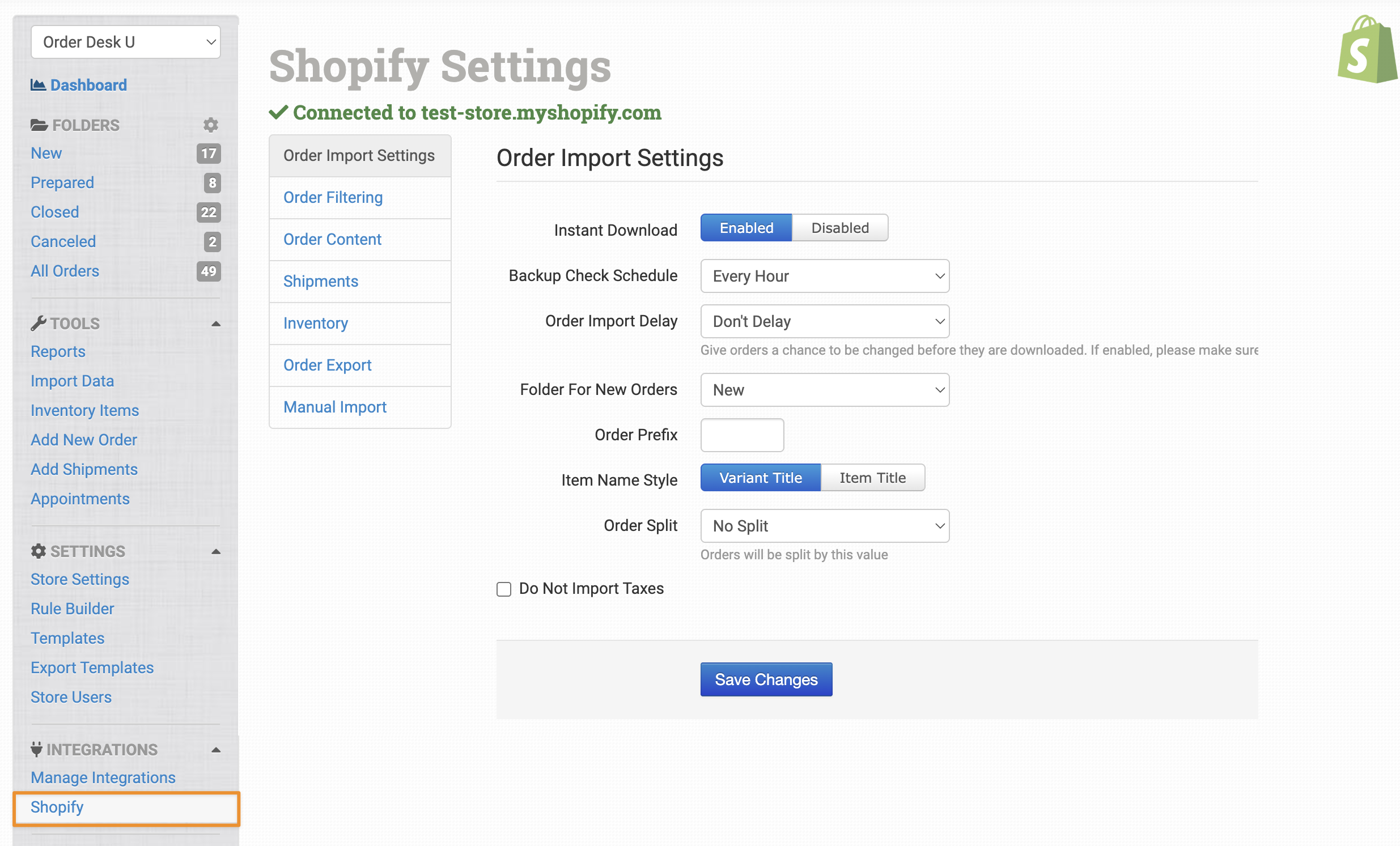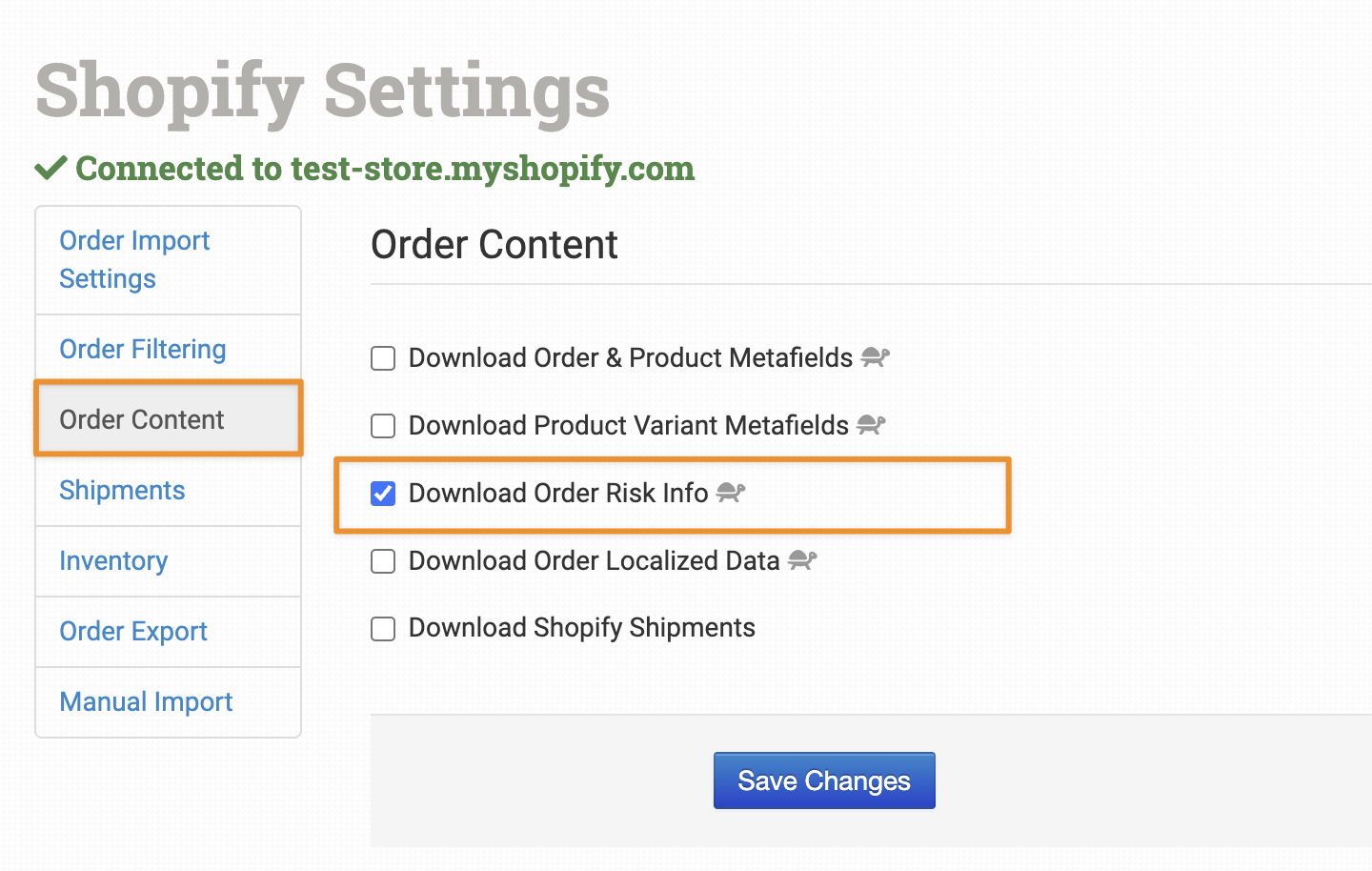How to Use Shopify Risk Scores to Stop Fraudulent Orders
Shopify has a risk score and recommendation system that can warn you about fraudulent orders. Most merchants want to automatically send their orders for fulfillment as soon as they are placed, but if you want to first check for and filter out any high risk orders, you can do so with Order Desk. This allows you to set any potentially fraudulent orders aside while everything else is still automatically sent for fulfillment.
Setting this up will depend on your existing order workflow and how you want to handle high risk orders. As with most aspects of Order Desk, this process is customizable and can be tweaked to meet your specific needs.
Download Risk Info
You will first need to bring in the Shopify risk score with your orders. To do this, go into your Shopify integration settings. In the left sidebar, look under the Integrations menu and click on Shopify.

Head into the Order Content tab and enable the Download Order Risk Info option.

This will not add risk related info for orders that have already been downloaded. It will bring in the risk info for all Shopify orders moving forward.
Order Metadata
Once enabled, Order Desk will pull in any risk information from Shopify on potentially fraudulent orders and will store it in the Order Metadata.
Order Metadata can be found at the bottom of the order details page.

If Shopify determines that there is no risk, the risk score will be 0 and there will be no further recommendations or messages from Shopify.

However, if anything about the order is suspicious, Shopify will assign a risk score between 0 and 1 and provide more information. The higher the score, the more suspicious the order is. In most cases, they'll include a message about why the order may be fraudulent and a recommendation to investigate or cancel the order.

Setting Aside Orders for Review
1. Create Review Folder
If you haven't already, create a new folder for any orders that will need to be set aside for review based on Shopify's recommendations. For instructions on creating a new folder, please read the Working with Folders guide.
2. Disable Automatic Submission through Integrations
If you are automatically submitting orders to any of your shipping or fulfillment integrations, disable these settings. You will need to create rules to submit orders instead since these settings will send all orders for fulfillment regardless of what your rules may say to do otherwise. Check all of your fulfillment and shipping integrations to make sure any setting that will automatically send orders to the integration is disabled:

There is one exception to this. If you are using the legacy ShipStation or the Shipworks integration, orders are pulled from a specific folder rather than being automatically sent to the service. This is okay to leave in place. The new ShipStation integration will need to be checked to make sure this setting is disabled.
3. Check Existing Rules for Automatic Submission
Got to your Rule Builder (click on Rule Builder in the left sidebar under Settings) and look for any rules that automatically submit orders for fulfillment or to a third party vendor.
If you don't have any rules yet, you can move on to the next step.
If you do have rules, make sure none of them are automatically sending all orders (or all Shopify orders) to a fulfillment service or sending out a dropship email. Any rules doing this will need a filter to prevents the potentially fraudulent orders from being automatically sent for fulfillment.
The filter you use will ultimately depend on the rules you have set up and how you want to make sure the fraudulent orders are kept from being sent. Our recommendation is to use the filter If Folder Name Does Not Equal, like this:
If Folder Name Does Not Equal Review
What this means is the rule will submit any orders that meet the filters except for orders in the review folder:

If your rule is only submitting orders from a specific folder, this filter isn't necessary since the risky orders will have been moved into the review folder and won't be in the folder the rule is looking at.
If you choose to set up different rules than this guide suggests, you may want to come back to this step after everything is set up to make sure the filters you choose to work with don't conflict with each other.
4. Create New Rule to Look for Risky Orders
Now that you've made sure your integrations and rules aren't going to pull or send any orders in the review folder, it's time to create the rule that will move orders into this folder.
Shopify uses a percentage scale between 0 and 1 to indicate how likely an order is fraud. The closer the number is to 1, the more likely the order is fraudulent. Most merchants choose to set their threshold at 0.5 or greater.
IMPORTANT
You are ultimately responsible for reviewing the orders in your store and preventing fraudulent orders from being fulfilled. Shopify's general guidance is to review orders with a risk level greater than 0.5. You may want to adjust this level in your rules as you see how their scoring system works.
In the Rule Builder, create a new rule for the Order Rule rule type:

For the event, select Order is Imported:

Under the Filters & Actions tab, click Add a Filter:

The filter will be the Shopify risk score threshold that you want to set. If you want to use .5 or higher, your filter will say
If Order Metadata Field shopify_risk_score Greater Than or Equal .5

Select the Change Folder action, and choose the review folder you created earlier.

Name and save your rule.
You can add other filters if you have any other special circumstances (such as if the order total is over a certain price point).
You may also want to add additional actions such as tagging the order red and sending the admin an email notification about the order.

For more information on working with email templates, please see this guide.
5. Move Rule to the Top of When Order is Imported Rules
This rule needs to run before any other rules or actions take place when orders are imported. That way it will move any high risk orders into your review folder immediately before any other rules start to run.
To make sure this happens, drag your risk rule to the top of your Order is Imported rules:

Next Steps
Once you have an order in the review folder, you can take the steps necessary to review it. If you decide the order is okay to fulfill, you can either manually send it for fulfillment by clicking on the submit to integration button on the order:

By manually sending the dropship email to your vendor:

Or by moving it into the folder where an integration or export template will pick it up at the scheduled time:

If you decide to cancel the order, please refer to our Canceling an Order guide for more information about how this works in Order Desk.
